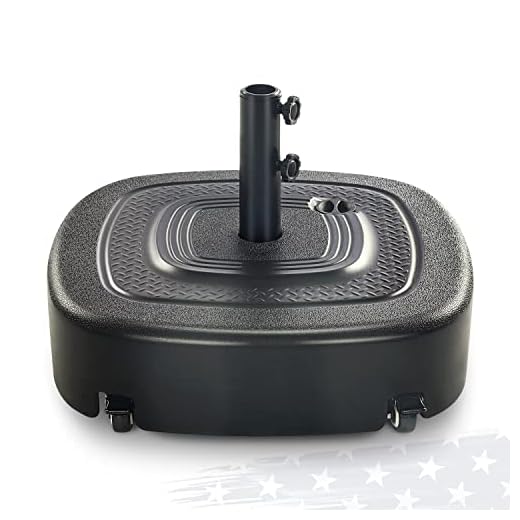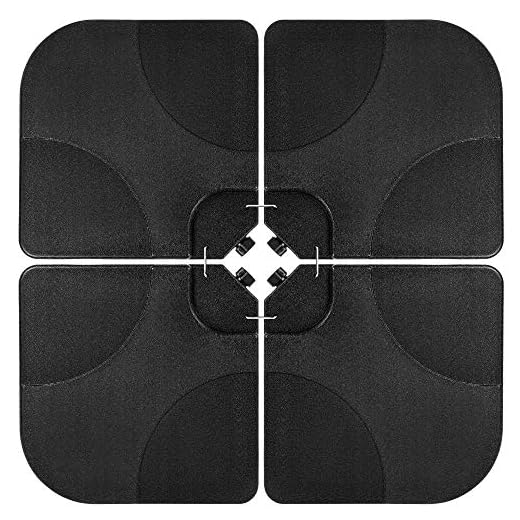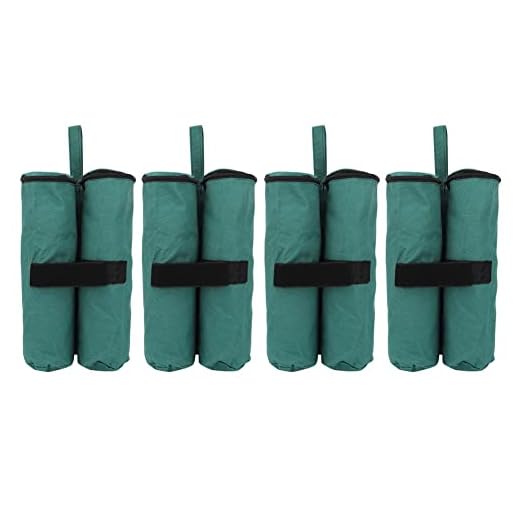




For those seeking stability in outdoor settings, opting for sand as a weight material is highly recommended. Its density ensures that your setup remains secure, preventing any unwanted tipping during breezy days. This article explores various options, including water, concrete, and sand, while providing insights into the advantages and disadvantages of each.
Homeowners, event planners, and outdoor enthusiasts will find this guide invaluable as it highlights key factors to consider when selecting a stabilizing agent. By understanding the properties of each material, you can make an informed choice that suits your specific needs.
In this article, you’ll discover the effectiveness of different materials, their ease of use, and long-term benefits. Whether you prioritize portability or durability, this comprehensive overview will help you select the most suitable option for your outdoor shade solution.
Best Filler for Umbrella Base
Choosing the right substance to weight down a patio shade structure is essential for stability and safety. Water and sand are among the most commonly used materials, each offering distinct advantages that can cater to different needs and environments.
Water is a convenient option, especially if the unit is designed to be filled and emptied easily. It provides adequate weight when filled to capacity and can be drained during the off-season or for storage. However, in colder climates, it’s crucial to ensure that any remaining water is removed to prevent freezing and cracking.
Sand as an Alternative
Opting for sand presents a more permanent solution. It is denser than water, providing greater stability without the risk of freezing issues. Filling a support with sand can also reduce the likelihood of leaks and spills, making it a practical choice for long-term use.
- Weight: Sand typically offers more weight per volume compared to water.
- Durability: Sand does not freeze or evaporate, ensuring long-lasting stability.
- Spill Prevention: Unlike water, sand does not leak out, minimizing messes.
For those seeking a balance between weight and convenience, a combination of both materials can be effective. Starting with sand for stability, then topping off with water can create a secure and manageable solution.
When selecting the right substance, consider factors such as ease of use, climate conditions, and storage options. Each choice has its merits and can significantly enhance the functionality of your shading solution.
Evaluating Weight Options for Stability
Choosing the right material for your support structure is critical for maintaining stability in various weather conditions. Heavy options, such as concrete or sand, provide a solid foundation that can withstand strong winds. These substances help anchor the setup securely, reducing the risk of tipping or shifting.
In contrast, lighter alternatives like water or air-filled options may be more portable but can compromise stability during inclement weather. It’s important to weigh the pros and cons of each material to find the right balance between mobility and security.
Comparative Analysis of Weight Options
| Material | Weight | Stability | Portability |
|---|---|---|---|
| Concrete | Heavy | High | Low |
| Sand | Moderate | High | Medium |
| Water | Light | Medium | High |
| Air-filled | Very Light | Low | Very High |
Considerations such as ease of transport and setup time also play a vital role in decision-making. While heavier materials promise better stability, they may hinder mobility and convenience. Lighter options offer flexibility but could lead to instability in adverse conditions.
- Evaluate the typical wind conditions in your area.
- Assess how often you plan to move the setup.
- Determine the balance between stability and ease of transport that suits your needs.
Comparing Sand vs. Water as Fillers
Choosing between sand and water for securing a shade structure involves weighing various factors. Sand provides stability through weight, while water offers convenience and ease of adjustment.
Sand is a commonly used substance due to its density and ability to resist movement. It can provide a solid foundation, making it less likely for the structure to topple in windy conditions. On the other hand, water is easily adjustable, allowing for quick changes in weight depending on the weather or location.
Pros and Cons
- Sand:
- Heavy and stable, ideal for windy conditions.
- Less prone to evaporation compared to water.
- Requires effort to fill and empty.
- Water:
- Easy to fill and drain, providing flexibility.
- Lightweight when empty, making transport simpler.
- Can evaporate over time, requiring refills.
Considering the environment where the structure will be used is crucial. In windy areas, sand might be preferable, while in calmer locations, water could suffice. Assessing your needs will lead to a more informed decision.
Impact of Filler Material on Durability
The choice of material used to fill support structures significantly influences their longevity and stability. High-density options tend to offer superior resistance to wear and environmental factors, thus enhancing the overall lifespan of the item.
Materials such as concrete or sand provide excellent weight distribution and prevent movement during adverse weather conditions. This stability is critical in ensuring that the structure remains upright and functional over time.
Factors Affecting Durability
Several key elements contribute to the durability of support structures:
- Weight: Heavier materials generally offer better stability.
- Moisture Resistance: Some materials degrade when exposed to water, affecting overall integrity.
- Temperature Variability: Certain fillers may expand or contract with temperature changes, impacting their effectiveness.
When selecting a material, consider the local climate and the expected load. For instance, areas prone to high winds may require denser options, while regions with fluctuating temperatures might benefit from materials that withstand thermal expansion.
| Material | Weight (lbs per cubic foot) | Moisture Resistance |
|---|---|---|
| Concrete | 150 | High |
| Sand | 100 | Moderate |
| Water | 62 | Low |
In summary, the right choice of material for filling support structures can significantly impact their durability and performance. Evaluating factors such as weight, moisture resistance, and environmental conditions will lead to better decision-making and longer-lasting solutions.
Cost-Effectiveness of Different Filler Choices
Choosing the right material to weigh down a canopy stand can significantly impact both stability and budget. Evaluating various options leads to informed decisions that balance quality and expense. Each option presents unique characteristics that influence overall costs.
Sand is often regarded as a practical choice, offering an affordable solution that is readily available. Its weight provides excellent stability; however, transportation and cleanup can be cumbersome. In contrast, water-filled alternatives are convenient and lightweight. They require less initial expenditure but may necessitate frequent refilling or maintenance, especially in varying weather conditions.
Comparative Analysis of Material Costs
| Material Type | Initial Cost | Weight | Maintenance |
|---|---|---|---|
| Sand | Low | Heavy | Low |
| Water | Very Low | Light | Medium |
| Concrete | Medium | Very Heavy | Low |
| Plastic Weights | Medium-High | Medium | Low |
In summary, while sand provides a reliable and inexpensive option, water-filled solutions offer convenience but may incur additional costs over time. Concrete presents a robust alternative but at a higher initial investment. Plastic weights balance usability and cost but may not be as economically favorable in the long run.
Ultimately, the choice hinges on individual needs, including portability, ease of use, and long-term financial implications. Selecting the most suitable option enhances both functionality and budget management.
Ease of Access and Maintenance for Canopy Supports
Choose a model with a removable and refillable compartment for weight. This feature simplifies the process of adding or replacing materials, ensuring stability without unnecessary hassle.
Regular maintenance is key to prolonging the life of your support system. Inspect the unit for any cracks or damage periodically. Clean the exterior with mild soap and water to remove dirt and prevent corrosion.
- Check the seals and joints to ensure no water is accumulating inside.
- Replenish weight materials as needed, especially after storms or heavy winds.
- Store the unit indoors during extreme weather to avoid wear and tear.
By selecting a support system that prioritizes accessibility and ease of upkeep, you ensure a reliable solution that meets your outdoor needs without excessive effort.
Best filler for umbrella base
Features
| Part Number | YT-00102670 |
| Model | YT-00102670G |
| Color | Black |
| Size | 41×41×3in |
Features
| Part Number | UBP18181-BR |
| Model | UBP18181-BR |
| Warranty | One year warranty on manufacturing defects |
| Color | Bronze |
| Is Adult Product | |
| Release Date | 2024-01-01T00:00:01Z |
| Size | 18-Inch |
Features
| Part Number | ZSUB37W |
| Model | ZSUB37W |
| Color | Black |
| Size | 1 |
Features
| Part Number | SKY3257 |
| Model | SKY3257 |
| Color | Black |
| Size | 4-Piece |
Features
| Part Number | LGBRLABASECROSS |
| Model | 4pcs Cantilever |
| Color | Black-Cross |
| Size | 176lbs |
Video:
FAQ:
What are the best materials to use as filler for an umbrella base?
Common materials for filling an umbrella base include sand, water, and concrete. Sand is popular because it’s heavy and easily accessible, making it effective for stabilizing the base. Water is convenient for those who want a lighter option but may not be suitable in colder climates where it can freeze. Concrete is the heaviest and most stable option, providing excellent support for larger umbrellas, but it can be more challenging to handle and install.
How much weight should the filler for an umbrella base have?
The weight of the filler depends on the size and type of the umbrella. Generally, a base should weigh at least 50 pounds for small to medium umbrellas, while larger umbrellas may require 75 to 100 pounds or more. It’s important to check the manufacturer’s recommendations for specific weight guidelines to ensure stability and safety.
Can I use water as a filler for an umbrella base?
Yes, using water as a filler is a viable option, especially for lighter or temporary setups. However, it’s crucial to ensure that the base is designed for water use and to consider potential issues such as freezing in cold weather, which can damage the base or cause it to crack. If you live in a climate where temperatures drop significantly, using sand or concrete may be a more reliable choice.
Is it better to use sand or concrete for an umbrella base filler?
The choice between sand and concrete largely depends on your needs. Sand is easier to handle, refill, and clean, making it a good choice for casual use. It allows for easy adjustments if you need to move the umbrella. Concrete, on the other hand, provides superior stability and is ideal for permanent or semi-permanent installations, especially for larger umbrellas. If you prioritize weight and stability, concrete might be the better option.
What are the disadvantages of using water in an umbrella base?
While water is a convenient filler, it has some drawbacks. One major concern is that it can freeze in colder weather, leading to potential damage to the umbrella base. Additionally, water can leak out over time, reducing stability and requiring frequent refills. If you’re looking for a more permanent solution, other materials like sand or concrete may be more suitable as they provide consistent weight and stability regardless of weather conditions.








